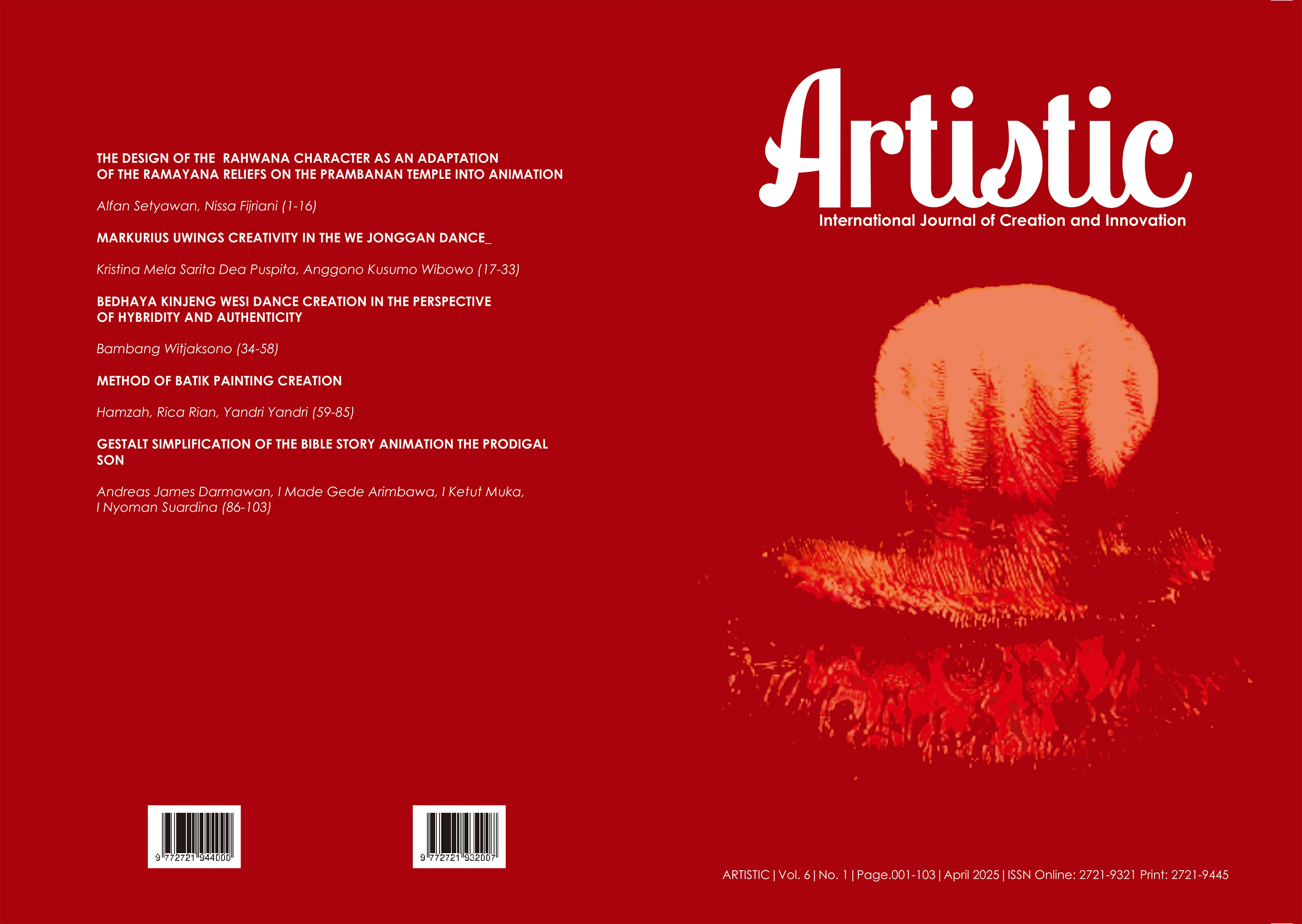GESTALT SIMPLIFICATION: BIBLE STORY ANIMATION 'THE PRODIGAL SON'
DOI:
https://doi.org/10.33153/artistic.v6i1.6434Keywords:
animation, Design, and graphic artsAbstract
Bible story animation 'The Prodigal Son' only presents the storyline without touching the theological meaning. Church youth experience boredom in understanding parable story of 'Prodigal Son'. The problem urgency is the lack of teaching media that convey repentance, forgiveness, and gratitude meaning in an interesting and contextual way. This study used descriptive qualitative method through literature, discussions, and FGD. The creation process involved application of Edgar Rubin's visual simplification theory and Max Wertheimer's, Wolfgang Köhler, Kurt Koffka Gestalt theory; combined with philosophy, hermeneutics, semiotics; to create new interesting and meaningful animation. The animation successfully visualizes the theological essence of repentance, forgiveness, and gratitude through simplified forms and meaningful gestalt compositions, offering a fresh visual narrative that resonates and supports deeper spiritual reflection for adolescent.
Downloads
References
Aquinas, T. (1981). Summa Theologica. Christian Classics.
Barron, R. (2015). The Priority of Christ: Toward a Postliberal Catholicism. Baker Academic.
Barthes, R. (1977). Image, Music, Text. Fontana Press.
Chandler, D. (2007). Semiotics: The Basics (2nd ed.). Routledge.
Darmawan, A. J., Sedana, I. N., & Marianto, M. D. (2023). Unveiling the Aesthetic Connection: Balinese Wayang Characters and the 'Prodigal Son' Bible Story. Dewa Ruci: Jurnal Pengkajian dan Penciptaan Seni, 18(1), 56-68, DOI: https://doi.org/10.33153/dewaruci.v18i1.4674.
Eco, U. (1979). A Theory of Semiotics. Indiana University Press.
Green, J. B. (1997). The Gospel of Luke. Eerdmans.
Keller, T. (2008). The Prodigal God: Recovering the Heart of the Christian Faith. Dutton.
Kress, G., & van Leeuwen, T. (2006). Reading Images: The Grammar of Visual Design (2nd ed.). Routledge.
Kristianto, J. (2024). Understanding The Creative Process behind The Budhist Song. ARTISTIC: International Journal of Creation and Innovation, 5(1), 17-28, DOI: https://doi.org/10.33153/artistic.v5i1.6230.
Kusumawati, I. R. (2024). Religion And Culture Based Arts Sustainability Model in The “Among” System: Empirical Study in Butuh, The Wayang Hamlet. ARTISTIC: International Journal of Creation and Innovation, 5(2), 34-45, DOI: https://doi.org/10.33153/artistic.v5i2.6437.
McCloud, S. (1994). Understanding Comics: The Invisible Art. HarperCollins Publishers.
Merriam, S. B. (2009). Qualitative Research: A Guide to Design and Implementation. Jossey-Bass.
Palmer, R. E. (1969). Hermeneutics: Interpretation Theory in Schleiermacher, Dilthey, Heidegger, and Gadamer. Northwestern University Press.
Piaget, J. (1972). The Psychology of the Child. Basic Books.
Rubin, E. (1921). Visuell Wahrgenommene Figuren: Studien in Psychologischer Analyse. Gyldendalske Boghandel.
Schattschneider, D. (1990). M.C. Escher: Visions of Symmetry. Harry N. Abrams.
Schleiermacher, F. (1998). Hermeneutics and Criticism and Other Writings. Cambridge University Press.
Stein, R. H. (1994). The Method and Message of Jesus’ Teachings. Westminster John Knox Press.
Thomas, F., & Johnston, O. (1981). The Illusion of Life: Disney Animation. Disney Productions.
Wertheimer, M. (1938). Laws of Organization in Perceptual Forms. In Ellis, W. (Ed.), A Source Book of Gestalt Psychology. Routledge & Kegan Paul.
Williams, R. (2001). The Animator’s Survival Kit. Faber and Faber.
Downloads
Published
How to Cite
Issue
Section
License
Copyright (c) 2025 Andreas James Darmawan, I Made Gede Arimbawa, I Ketut Muka, I Nyoman Suardina

This work is licensed under a Creative Commons Attribution-NonCommercial-ShareAlike 4.0 International License.
Copyright
Authors who publish with Artistic agree to the following terms:
- Authors retain copyright and grant the journal right of first publication with the work simultaneously licensed under a Creative Commons Attribution License (CC BY-SA 4.0) that allows others to share the work with an acknowledgment of the work's authorship and initial publication in this journal.
- Authors are able to enter into separate, additional contractual arrangements for the non-exclusive distribution of the journal's published version of the work (e.g., post it to an institutional repository or publish it in a book), with an acknowledgment of its initial publication in this journal.
This work is licensed under a Creative Commons Attribution-ShareAlike 4.0


